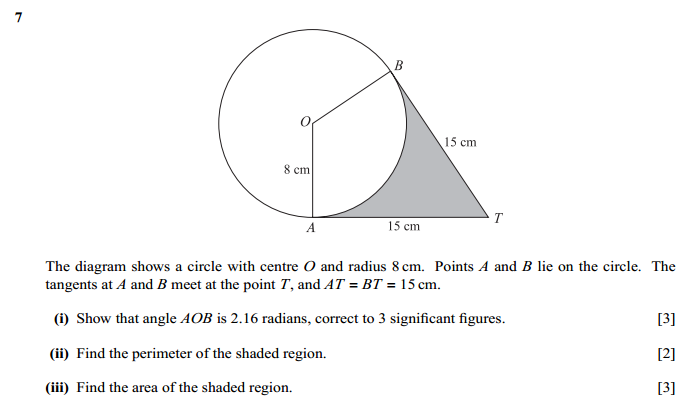Math Is Fun Forum
You are not logged in.
- Topics: Active | Unanswered
#76 Re: Dark Discussions at Cafe Infinity » Happy Pi Day! » 2015-03-13 22:38:20
Happy birthday to this chap!
[list=*]
[*] [/*]
[/*]
[/list]
#77 Re: Help Me ! » inequilities » 2015-03-09 04:30:59
[list=*]
[*]
[/list] either all the factors are positive, or two of them are negative and one positive.
#78 Re: Help Me ! » inequilities » 2015-03-08 04:36:18
[list=*]
[*]
[/list] (multiplying both sides by and reversing the inequality)So the answer is . The book is correct.
#79 Re: Help Me ! » circle » 2015-03-04 23:11:00
Thanks Bob! ![]()
#80 Re: Help Me ! » circle » 2015-03-04 22:05:02
Why doesn't your diagram have OA as diameter? The equation of the circle is
[list=*]
[*]
[/list]
which can be rearranged as
[list=*]
[*]
[/list]which is a circle centred on = midpoint of OA with radius .
Does not that make OA the diameter?
#81 Re: Help Me ! » circle » 2015-03-04 21:23:41
Do I get a medal for solving this tough problem?
#82 Re: Help Me ! » circle » 2015-03-04 21:22:36
Let A be the point (p,q). The circle is
[list=*]
[*]
[/list]
Clearly the circle passes through the origin O and the point A and has radius OA/2. Thus OA is the diameter the circle.
Because of symmetry we can assume WLOG that p, q > 0 (i.e. A is in the first quadrant). Let a chord drawn from A intersect the x-axis at (t,0). One end of the chord is A; if the axis bisects it, the other end would be (P,Q) where:
[list=1]
[*]
[*][/*]
[/list]
Susbstiting (x,y) = (P,Q) into the equation of the circle and simplifying gives the following quadratic equation in t:
[list=*]
[*]
[/list]
This equation has two real and distinct solutions in t; therefore its discriminant is strictly positive:
[list=*]
[*]
[/list]
#83 Re: Formulas » maths A-level past year circles » 2015-03-03 20:34:18
It's not a trapezium; it's a kite.

Find the area of triangle OAT and multiply by 2. (Then subtract the area of the sector of the circle.)
#85 Re: Exercises » Compute the solution: » 2015-02-28 11:10:36
204. Find the first terms of the sequence given by
and for n > 2.
#86 Re: Dark Discussions at Cafe Infinity » Words that contain AEIOU, in any order, each vowel exactly once » 2015-02-27 04:56:26
EAIOU
behaviour
edacious
gelatinous
gregarious
mendacious
nefarious
precarious
predacious
tenacious
veracious
vexatious
hellacious
UAIOE
glutathione
quadripole
ultraviolet
unfashioned
#88 Re: Help Me ! » Help with a fairly simple proof please? » 2015-02-26 00:13:24
Yes, that works fine. It's along the lines of what zetafunc suggested in post #2. ![]()
#89 Re: Help Me ! » Help with a fairly simple proof please? » 2015-02-25 21:33:42
No. Try n and n+2 for n even.
#90 Re: Help Me ! » Help with a fairly simple proof please? » 2015-02-25 01:09:46
[list=*]
[*]
[/list]
#91 Jokes » Harry Hole » 2015-02-24 21:58:13
- Olinguito
- Replies: 0
It's been a while since I read a detective thriller by Norwegian crime-fiction novelist Jo Nesbø. For those of you know not familiar with this writer, he is the creator of the policeman Harry Hole. In the last book I read, Phantom, Hole has a son called Oleg. I thought that was a disappointment - because I thought he should have called him Bart. In fact he should have lots of children, all of them boys and all of them called Bart. Some of them would be adopted - but some would be biologically his. This would mean...
#92 Re: Help Me ! » How do I show that this function is a constant? » 2015-02-23 23:35:52
I think it's like. this. Let
[list=*]
[*]
[/list]And . The problem is to show that is independent of the choice of x, right?
#93 Re: Help Me ! » Final "Higher Derivatives" Question » 2015-02-23 23:26:29
Well, I think you've worked out the problem correctly using calculus, so never mind Wolfram|Alpha. ![]()
This problem is typical of olympiad inequality problems requiring quick manipulations using algebra rather than calculus. Thus, applying AM–GM, we have
It is easily seen that in the interval the expression attains a maximum at , the maximum being . Hence the minimum of in that interval is and so:#94 Re: Help Me ! » Final "Higher Derivatives" Question » 2015-02-22 22:46:06
#96 Re: Exercises » Compute the solution: » 2015-02-20 22:15:31
Grrr, silly me. For #185 I used sin instead of tan. I am really angry with myself. ![]()
#99 Re: Help Me ! » Calculus Proof » 2015-02-18 20:34:11
[list=*]
[*]
[/list]
This is < 0 when k < 1 and > 0 when k > 1.